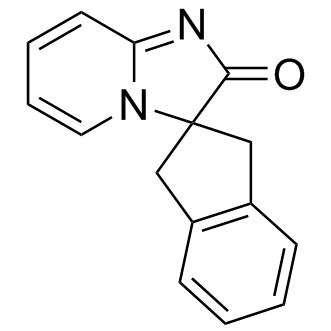
ZSET1446
CAS No. 887603-94-3
ZSET1446( ST101 | ZSET-1446 | ZSET 1446 | ST-101 | ST 101 )
Catalog No. M16417 CAS No. 887603-94-3
A small molecule cognitive enhancer that potentiates acetylcholine-mediated facilitation of inhibitory synaptic transmission in the hippocampal neurons.
Purity : >98% (HPLC)
 COA
COA
 Datasheet
Datasheet
 HNMR
HNMR
 HPLC
HPLC
 MSDS
MSDS
 Handing Instructions
Handing Instructions
| Size | Price / USD | Stock | Quantity |
| 2MG | 104 | Get Quote |


|
| 5MG | 165 | Get Quote |


|
| 10MG | 233 | Get Quote |


|
| 25MG | 470 | Get Quote |


|
| 50MG | 683 | Get Quote |


|
| 100MG | 954 | Get Quote |


|
| 200MG | Get Quote | Get Quote |


|
| 500MG | Get Quote | Get Quote |


|
| 1G | Get Quote | Get Quote |


|
Biological Information
-
Product NameZSET1446
-
NoteResearch use only, not for human use.
-
Brief DescriptionA small molecule cognitive enhancer that potentiates acetylcholine-mediated facilitation of inhibitory synaptic transmission in the hippocampal neurons.
-
DescriptionA small molecule cognitive enhancer that potentiates acetylcholine-mediated facilitation of inhibitory synaptic transmission in the hippocampal neurons; increases the extracellular ACh in the cortex and hippocampus and enhances nicotine-stimulated ACh release in the hippocampus in normal rats, without affecting nAChRs.Alzheimer's Disease Phase 2 Discontinued(In Vitro):ZSET1446 (100 pM-10 nM) exerts limited effects on the basal neuronal excitability and synaptic transmission. ZSET1446 potentiates the facilitatory effect of nAChR stimulation on sPSC frequency. ZSET1446 potentiates the increase in sIPSC frequency by local application of nicotine (5 μM; 2 minutes) without affecting the basal sIPSC frequency at the range of 10 pM to 1 nM.(In Vivo):ZSET1446 enhances object recognition memory in mice and ameliorates cognitive impairment caused by scopolamine in rats. Concomitant administration of subeffective doses of ZSET1446 and memantine significantly ameliorates the cognitive performance in the novel object recognition task in both mice and rats. Moreover, oral administration of ZSET1446 or memantine increases the extracellular level of ACh in the hippocampus as compared with the control. Further, concomitant administration of subeffective doses of ZSET1446 and memantine significantly increases the extracellular level of ACh as compared with the group of ZSET1446 or memantine alone. ZSET1446 (0.002, 0.01, and 0.1 mg/kg, p.o.) ameliorates cognitive deficits of SAMP8 after 4, 8, 12, and 16 weeks of treatment in a novel object recognition test. ZSET1446 also reduces grading scores of SAMP8 after 16 weeks of treatment. Further, 8-week treatment of ZSET1446 significantly reduces the total number of Aβ-positive granules in the hippocampus.
-
In VitroZSET1446 (100 pM-10 nM) exerts limited effects on the basal neuronal excitability and synaptic transmission. ZSET1446 potentiates the facilitatory effect of nAChR stimulation on sPSC frequency. ZSET1446 potentiates the increase in sIPSC frequency by local application of nicotine (5 μM; 2 minutes) without affecting the basal sIPSC frequency at the range of 10 pM to 1 nM.
-
In VivoZSET1446 enhances object recognition memory in mice and ameliorates cognitive impairment caused by scopolamine in rats. Concomitant administration of subeffective doses of ZSET1446 and memantine significantly ameliorates the cognitive performance in the novel object recognition task in both mice and rats. Moreover, oral administration of ZSET1446 or memantine increases the extracellular level of ACh in the hippocampus as compared with the control. Further, concomitant administration of subeffective doses of ZSET1446 and memantine significantly increases the extracellular level of ACh as compared with the group of ZSET1446 or memantine alone. ZSET1446 (0.002, 0.01, and 0.1 mg/kg, p.o.) ameliorates cognitive deficits of SAMP8 after 4, 8, 12, and 16 weeks of treatment in a novel object recognition test. ZSET1446 also reduces grading scores of SAMP8 after 16 weeks of treatment. Further, 8-week treatment of ZSET1446 significantly reduces the total number of Aβ-positive granules in the hippocampus.
-
SynonymsST101 | ZSET-1446 | ZSET 1446 | ST-101 | ST 101
-
PathwayMembrane Transporter/Ion Channel
-
TargetnAChR
-
RecptornAChR
-
Research AreaNeurological Disease
-
IndicationAlzheimer Disease
Chemical Information
-
CAS Number887603-94-3
-
Formula Weight236.2686
-
Molecular FormulaC15H12N2O
-
Purity>98% (HPLC)
-
SolubilityDMSO: ≥ 34 mg/mL
-
SMILESO=C1N=C2C=CC=CN2C13CC4=C(C=CC=C4)C3
-
Chemical NameSpiro[imidazo[1,2-a]pyridine-3(2H),2'-[2H]inden]-2-one, 1',3'-dihydro-
Shipping & Storage Information
-
Storage(-20℃)
-
ShippingWith Ice Pack
-
Stability≥ 2 years
Reference
1. Yamaguchi Y, et al. J Pharmacol Exp Ther. 2006 Jun;317(3):1079-87.
2. Ito Y, et al. J Pharmacol Exp Ther. 2007 Feb;320(2):819-27.
3. Han F, et al. J Pharmacol Exp Ther. 2008 Jul;326(1):127-34.
4. Shioda N, et al. J Pharmacol Exp Ther. 2010 Apr;333(1):43-50.
molnova catalog



related products
-
Galanthamine
A potent allosteric potentiating ligand of human nAChRs α4β2, α3β4, and α6β4; potentiates agonist responses of the four nAChR subtypes at 0.1-1 uM.
-
AQW-051
AQW-051 is a novel, potent and selective, orally bioavailable, brain-penetrant α7 nAChR partial agonist with pKd of 7.56.
-
Nelonicline
Nelonicline (ABT-126) is a potent, selective α7 nicotinic receptor (nAChR) partial agonist for the treatment of cognitive impairment with schizophrenia.



 Cart
Cart
 sales@molnova.com
sales@molnova.com


